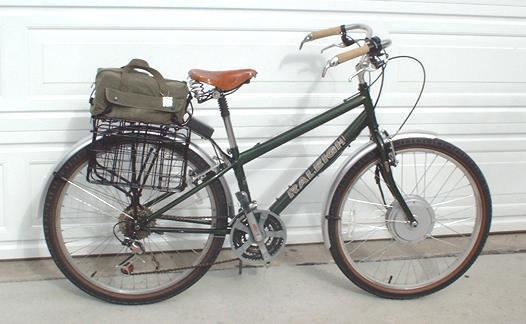 | ||
The wheel hub motor (also called wheel motor, wheel hub drive, hub motor or in-wheel motor) is an electric motor that is incorporated into the hub of a wheel and drives it directly.
Contents
History
The electric wheel hub motor was raced by Ferdinand Porsche in 1897 in Vienna, Austria. Porsche's first engineering training was electrical, not internal combustion based. As a result, he developed his first cars as electric cars with electric wheel hub motors that ran on batteries. The Lohner Porsche, fitted with one wheel motor in each of the front wheels, appeared at the World Exhibition in Paris in 1900 and created a sensation in the young automobile world. In the following years, 300 Lohner Porsches were made and sold to wealthy buyers.
Eventually the growth in power of the gasoline engine overtook the power of the electric wheel hub motors and this made up for any losses through a transmission. As a result, autos moved to gas engines with transmissions, but they were never as efficient as electric wheel hub motors.
Uses in current and future vehicles
Concept cars
Several concept cars have been developed using in-wheel motors:
Mechanism
Hub motor electromagnetic fields are supplied to the stationary windings of the motor. The outer part of the motor follows, or tries to follow, those fields, turning the attached wheel. In a brushed motor, energy is transferred by brushes contacting the rotating shaft of the motor. Energy is transferred in a brushless motor electronically, eliminating physical contact between stationary and moving parts. Although brushless motor technology is more expensive, most are more efficient and longer-lasting than brushed motor systems.
A hub motor typically is designed in one of three configurations. Considered least practical is an axial-flux motor, where the stator windings are typically sandwiched between sets of magnets. The other two configurations are both radial designs with the motor magnets bonded to the rotor; in one, the inner rotation motor, the rotor sits inside the stator, as in a conventional motor. In the other, the outer-rotation motor, the rotor sits outside the stator and rotates around it. The application of hub motors in vehicular uses is still evolving, and neither configuration has become standard.
Electric motors have their greatest torque at startup, making them ideal for vehicles as they need the most torque at startup too. The idea of "revving up" so common with internal combustion engines is unnecessary with electric motors. Their greatest torque occurs as the rotor first begins to turn, which is why electric motors do not require a transmission. A gear-down arrangement may be needed, but unlike in a transmission normally paired with a combustion engine, no shifting is needed for electric motors.
Wheel hub motors are increasingly common on electric bikes and electric scooters in some parts of the world, especially Asia.
Comparison with conventional EV design in automobiles
Compared with the conventional electric vehicle design with one motor situated centrally driving two (sometimes four) wheels by axles, the wheel motor arrangement has certain advantages and disadvantages:
Drive by wire
Cars with electronic control of brakes and acceleration provide more opportunities for computerized vehicle dynamics such as:
While some of these features have started to appear as options for some internal combustion engine vehicles, optional ABS brakes can add up to $2,000 to the cost of a base model.
As wheel motors brake and accelerate a vehicle with a single solid state electric/electronic system many of the above features can be added as software upgrades rather than requiring additional systems/hardware be installed like with ABS etc. This should lead to cheaper active dynamic safety systems for wheel motor equipped road vehicles.
Weight savings
Eliminating mechanical transmission including gearboxes, differentials, drive shafts and axles provide a significant weight and manufacturing cost saving, while also decreasing the environmental impact of the product.
Unsprung weight concerns
The major disadvantage of wheel hub motors are that the weight of the electric motors would increase the unsprung weight, which adversely affects handling and ride (the wheels are more sluggish in responding to road conditions, especially fast motions over bumps, and transmit the bumps to the chassis instead of absorbing them). Most conventional electric motors include ferrous material composed of laminated electrical steel. This ferrous material contributes most of the weight of electric motors. To minimize this weight several recent wheel motor designs have minimized the electrical steel content of the motor by utilizing a coreless design with Litz wire coil windings to reduce eddy current losses. This significantly reduces wheel motor weight and therefore unsprung weight.
Another method used is to replace the cast iron friction brake assembly with a wheel motor assembly of similar weight. This results in no net gain in unsprung weight and a car capable of braking up to 1G. A good example of this is the Michelin Active Wheel motor as fitted to the Heuliez Will that results in an unsprung weight of 35 kg on the front axle which compares favorably to a small car such as a Renault Clio that has 38 kg of unsprung weight on its front axle.
